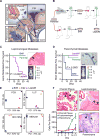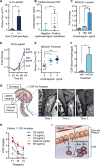Complement Component 3 Adapts the Cerebrospinal Fluid for Leptomeningeal Metastasis
- PMID: 28283064
- PMCID: PMC5405733
- DOI: 10.1016/j.cell.2017.02.025
Complement Component 3 Adapts the Cerebrospinal Fluid for Leptomeningeal Metastasis
Abstract
We molecularly dissected leptomeningeal metastasis, or spread of cancer to the cerebrospinal fluid (CSF), which is a frequent and fatal condition mediated by unknown mechanisms. We selected lung and breast cancer cell lines for the ability to infiltrate and grow in CSF, a remarkably acellular, mitogen-poor metastasis microenvironment. Complement component 3 (C3) was upregulated in four leptomeningeal metastatic models and proved necessary for cancer growth within the leptomeningeal space. In human disease, cancer cells within the CSF produced C3 in correlation with clinical course. C3 expression in primary tumors was predictive of leptomeningeal relapse. Mechanistically, we found that cancer-cell-derived C3 activates the C3a receptor in the choroid plexus epithelium to disrupt the blood-CSF barrier. This effect allows plasma components, including amphiregulin, and other mitogens to enter the CSF and promote cancer cell growth. Pharmacologic interference with C3 signaling proved therapeutically beneficial in suppressing leptomeningeal metastasis in these preclinical models.
Keywords: GDNF; PDGF; amphiregulin; brain metastasis; carcinomatous meningitis; cerebrospinal fluid breast cancer; choroid plexus; complement C3; leptomeningeal metastasis; lung cancer.
Copyright © 2017 Elsevier Inc. All rights reserved.
Figures







Comment in
-
Metastasis: Breaching barriers.Nat Rev Cancer. 2017 May;17(5):270. doi: 10.1038/nrc.2017.27. Epub 2017 Apr 7. Nat Rev Cancer. 2017. PMID: 28386090 No abstract available.
References
-
- Addison CL, Ding K, Zhao H, Le Maitre A, Goss GD, Seymour L, Tsao MS, Shepherd FA, Bradbury PA. Plasma transforming growth factor alpha and amphiregulin protein levels in NCIC Clinical Trials Group BR.21. J Clin Oncol. 2010;28:5247–5256. - PubMed
-
- Ames RS, Lee D, Foley JJ, Jurewicz AJ, Tornetta MA, Bautsch W, Settmacher B, Klos A, Erhard KF, Cousins RD, et al. Identification of a selective nonpeptide antagonist of the anaphylatoxin C3a receptor that demonstrates antiinflammatory activity in animal models. J Immunol. 2001;166:6341–6348. - PubMed
-
- Ames RS, Li Y, Sarau HM, Nuthulaganti P, Foley JJ, Ellis C, Zeng Z, Su K, Jurewicz AJ, Hertzberg RP, et al. Molecular cloning and characterization of the human anaphylatoxin C3a receptor. J Biol Chem. 1996;271:20231–20234. - PubMed
-
- An YJ, Cho HR, Kim TM, Keam B, Kim JW, Wen H, Park CK, Lee SH, Im SA, Kim JE, et al. An NMR metabolomics approach for the diagnosis of leptomeningeal carcinomatosis in lung adenocarcinoma cancer patients. Int J Cancer. 2015;136:162–171. - PubMed
Publication types
MeSH terms
Substances
Grants and funding
LinkOut - more resources
Full Text Sources
Other Literature Sources
Molecular Biology Databases
Research Materials
Miscellaneous

